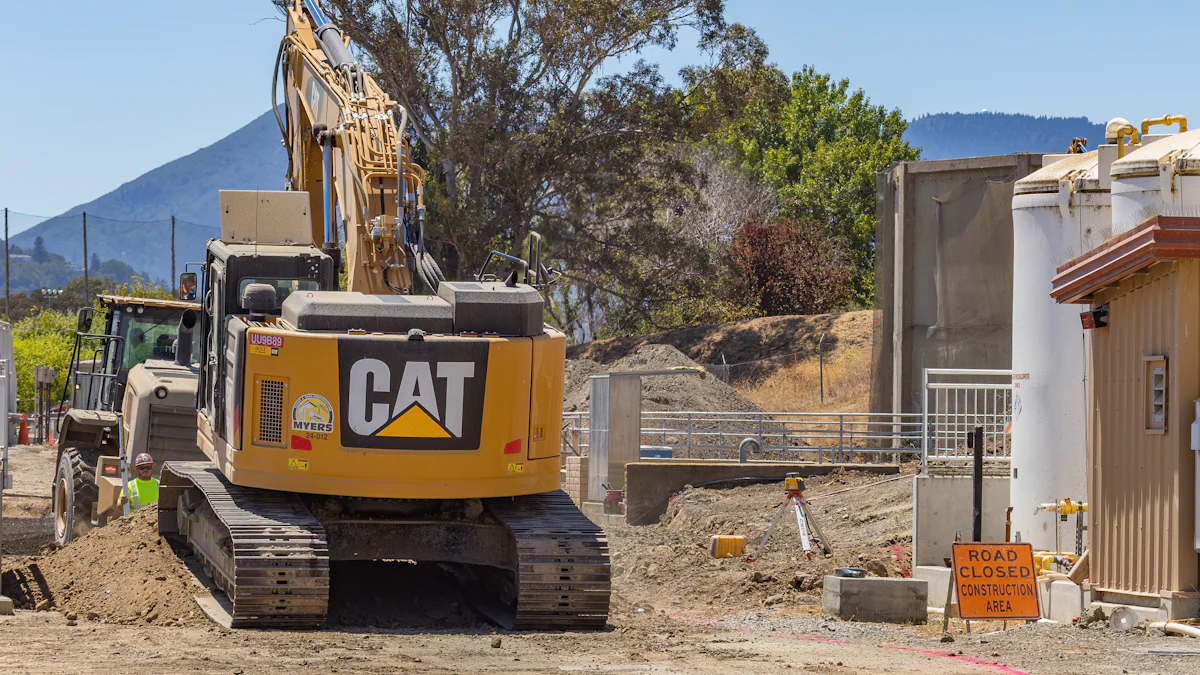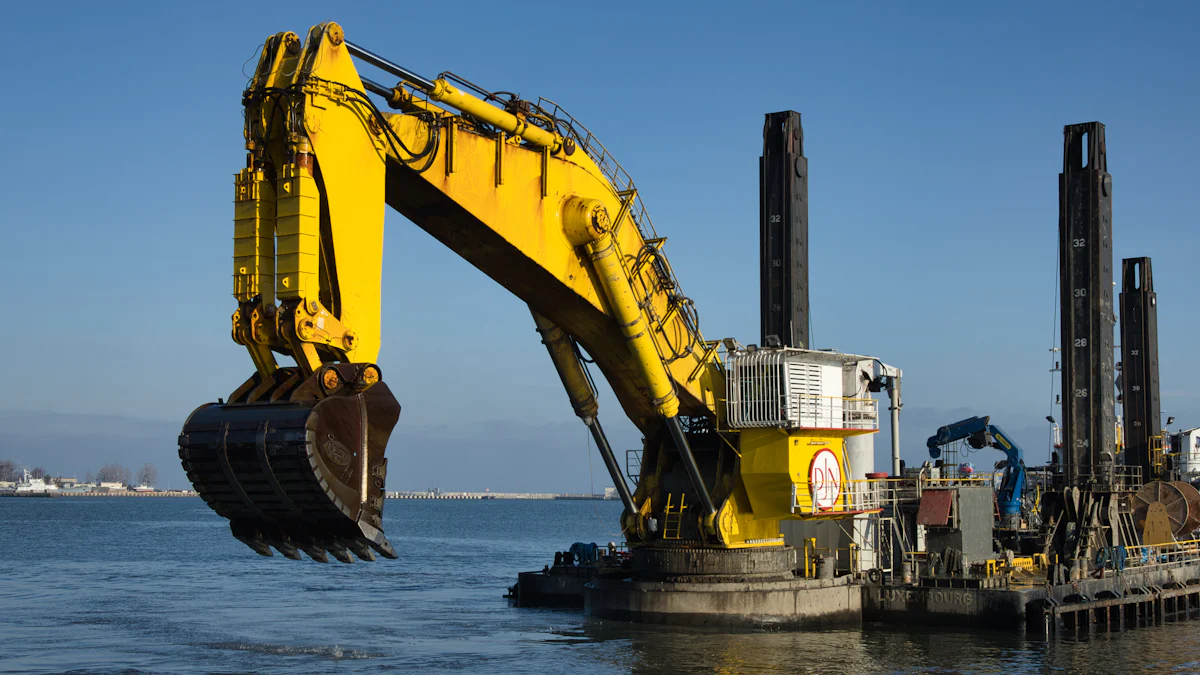
Excavators have transformed the way humans approach earth-moving works, becoming indispensable in modern construction machinery. Their journey, rooted in excavator history, began with primitive tools used by ancient civilizations like the Egyptians and Romans, who relied on manual labor for excavation. Over centuries, advancements like steam-powered excavators in the 1800s and hydraulic systems in the 1950s revolutionized efficiency and precision. Today, excavators play a vital role in shaping infrastructure, capable of handling gravel, soil, and ore with unmatched power. The evolution history of excavators reflects humanity’s drive to innovate and overcome challenges in construction and beyond.
Key Takeaways
Excavators have evolved from simple manual tools used by ancient civilizations to complex machines that are essential in modern construction.
The invention of steam shovels in the 19th century marked a significant turning point, increasing excavation efficiency and reducing reliance on manual labor.
The transition to hydraulic systems in the mid-20th century revolutionized excavators, enhancing precision, reliability, and versatility in various applications.
Modern excavators now incorporate GPS and automation technologies, allowing for greater accuracy and efficiency in construction projects.
Sustainability is becoming a priority in excavator design, with hybrid technology reducing emissions and operational costs while maintaining performance.
YNF Machinery plays a crucial role in the excavator industry by providing high-quality parts that enhance machine performance and support global infrastructure projects.
The future of excavators lies in AI and robotics, paving the way for fully autonomous machines that promise increased productivity and safety on construction sites.
Excavator History: Early Digging Tools and Predecessors
Ancient Tools and Manual Labor
The roots of excavator history stretch back to ancient civilizations, where humans relied on basic tools and manual labor to move earth. Early societies, such as the Egyptians and Romans, used rudimentary equipment like shovels, picks, and wooden levers to dig and transport soil. These tools, though simple, played a crucial role in constructing monumental structures like the pyramids and aqueducts.
Historians have uncovered evidence of ancient workers employing simple machines, such as pulleys and inclined planes, to enhance their efficiency. These innovations marked the beginning of the development of excavators, as they laid the foundation for more advanced earth-moving techniques. Despite their limitations, these early tools demonstrated humanity’s ingenuity in overcoming physical challenges.
Early Mechanical Prototypes and Innovations
The journey toward modern excavators began with mechanical prototypes that emerged during the late 15th century. These early designs aimed to reduce the reliance on manual labor by incorporating basic mechanical principles. However, it was not until the Industrial Revolution in the 18th century that significant progress occurred. The invention of the steam engine revolutionized machinery, paving the way for the world’s first excavator.
In 1830, William Otis patented the first excavator invented, a steam-powered machine that transformed excavation practices. This groundbreaking invention introduced a new era in the history of the excavator, enabling faster and more efficient digging. Steam shovels, as they were called, operated on rails and utilized steam engines to power their movements. These machines became indispensable for large-scale projects, such as railway construction and mining operations.
The development of excavators continued to evolve throughout the 19th century, with improvements in design and functionality. Early excavators showcased the potential of mechanized digging, setting the stage for the hydraulic systems that would later dominate the industry. These advancements reflected humanity’s relentless pursuit of innovation and efficiency in construction and infrastructure development.
The Invention of Steam Shovels and Their Impact

The Birth of Steam-Powered Excavators
The invention of steam shovels in the 19th century marked a turning point in excavation history. William Otis, an American inventor, introduced the first steam-powered excavator in 1839, revolutionizing earth-moving techniques. This machine, commonly referred to as a steam shovel, operated on rails and utilized a steam engine to power its movements. Its design included a bucket attached to an arm and a swinging boom, enabling it to dig and transport soil with unprecedented efficiency.
The invention of steam shovels replaced manual labor with mechanized digging, significantly increasing productivity. These machines became the first high-powered construction tools capable of handling large-scale projects. Their ability to move vast amounts of earth quickly and efficiently made them indispensable in industries such as mining and construction. The introduction of the continuous extractor steam shovel further enhanced their capabilities, allowing for smoother and more consistent operations.
Steam shovels laid the foundation for modern excavation machinery. They demonstrated the potential of self-powered equipment, paving the way for future innovations in the field. By reducing reliance on human labor, they transformed how construction and industrial projects were approached, setting a new standard for efficiency and precision.
Contributions to Industrial and Infrastructure Projects
The invention of steam shovels played a critical role in advancing industrialization and infrastructure development. These machines became essential for constructing monumental projects like the Panama Canal and the Trans-Siberian Railway. Their ability to handle heavy-duty tasks allowed engineers to tackle challenges that were previously insurmountable.
In mining, steam shovels proved invaluable for extracting minerals from the earth. Their robust design enabled them to operate in harsh conditions, making them a preferred choice for open-cast mining operations. Additionally, they facilitated the construction of canals, railway lines, and large industrial plants, contributing to the rapid expansion of urban and industrial landscapes.
By the early 20th century, rail-mounted steam shovels had become a common sight on construction sites. These machines, equipped with flanged wheels, operated on railroad tracks, ensuring mobility and stability during operations. Although later advancements in technology rendered them obsolete, their impact on the construction industry remains undeniable. They set the stage for the development of hydraulic systems and full-revolving excavators, which dominate the industry today.
The legacy of the invention of steam shovels endures as a testament to human ingenuity. These machines not only revolutionized excavation techniques but also reshaped the possibilities of industrial and infrastructure projects, leaving a lasting imprint on modern engineering.
Hydraulic Excavator Revolution: A Game-Changer

Transition from Steam to Hydraulic Systems
The transition from steam-powered machines to hydraulic systems marked a pivotal moment in the history of excavation technology. Steam shovels, while revolutionary for their time, had limitations in precision and efficiency. The introduction of hydraulic power in the mid-20th century addressed these challenges, transforming the capabilities of excavators. Hydraulic systems replaced steam engines with fluid mechanics, enabling smoother and more controlled movements.
Hydraulic excavators utilized pressurized fluid to power their components, such as booms, arms, and buckets. This innovation allowed operators to perform tasks with greater accuracy and speed. Unlike steam-powered machines, hydraulic systems required less maintenance and offered enhanced reliability. These advances not only improved the functionality of excavators but also expanded their applications across various industries, including construction, mining, and agriculture.
The hydraulic excavator revolution redefined the standards of excavation. It introduced a level of precision and versatility that was previously unattainable. By adopting hydraulic systems, manufacturers created machines capable of handling complex tasks with ease, setting a new benchmark for efficiency in the construction industry.
Advantages of Hydraulic Technology in Excavator Design
Hydraulic technology brought numerous advantages to excavator design, making these machines indispensable in modern engineering. One of the most significant benefits was the increased efficiency of operations. Hydraulic systems allowed excavators to perform tasks faster and with less energy consumption compared to their steam-powered predecessors. This improvement translated into reduced operational costs and higher productivity on job sites.
Another key advantage was the enhanced safety provided by hydraulic excavators. The precise control offered by hydraulic systems minimized the risk of accidents during excavation. Operators could maneuver the machine with greater accuracy, even in challenging environments. This feature proved invaluable in projects requiring delicate handling, such as urban construction or archaeological excavations.
Hydraulic technology also contributed to the versatility of excavators. Modern designs incorporated features like interchangeable attachments, enabling a single machine to perform multiple functions. From digging trenches to demolishing structures, hydraulic excavators adapted to a wide range of tasks. This adaptability made them a preferred choice for contractors and engineers worldwide.
The hydraulic excavator revolution not only improved the performance of these machines but also reshaped the construction industry. By combining efficiency, safety, and versatility, hydraulic technology elevated excavators to an essential tool in modern infrastructure development.
The Birth of Modern Excavators: Technological Advancements
Integration of GPS and Automation
The birth of modern excavators introduced groundbreaking innovations that transformed the construction industry. One of the most significant advancements was the integration of GPS technology and automation systems. These features enhanced the precision and efficiency of excavation tasks, setting a new standard for accuracy in construction projects.
Modern excavators equipped with GPS systems allow operators to achieve precise positioning and navigation. This technology enables machines to follow pre-programmed paths, ensuring consistent digging and grading. For example, road construction projects benefit greatly from this innovation, as it minimizes errors and reduces material waste. Operators can monitor the machine’s movements in real-time, making adjustments as needed to maintain accuracy.
Automation further revolutionized the capabilities of modern excavators. Intelligent control systems now monitor critical aspects such as fuel consumption, engine performance, and maintenance schedules. These systems optimize operations, ensuring that the machine performs at its best while reducing downtime. Automation also enhances safety by providing operators with detailed data about the excavator’s condition, allowing them to address potential issues before they escalate.
The integration of GPS and automation has redefined the role of excavators in construction. These technologies not only improve productivity but also contribute to safer and more sustainable practices. By combining precision with advanced monitoring, modern excavators have become indispensable tools in infrastructure development.
Sustainability and Hybrid Excavator Technology
As environmental concerns grow, the construction industry has embraced sustainability through hybrid excavator technology. The birth of modern excavators marked a shift toward eco-friendly solutions, addressing the need for reduced emissions and energy consumption.
Hybrid excavators combine traditional diesel engines with electric motors, offering a more sustainable alternative to conventional machines. This design reduces fuel consumption, lowering operational costs and minimizing the environmental impact. By using energy-efficient systems, hybrid excavators contribute to cleaner construction practices without compromising performance.
Manufacturers have also focused on developing materials and components that enhance the durability of modern excavators. Longer-lasting parts reduce the frequency of replacements, decreasing waste and conserving resources. Additionally, hybrid technology supports quieter operations, making these machines suitable for urban environments where noise pollution is a concern.
The adoption of hybrid excavator technology reflects the industry’s commitment to sustainability. These machines demonstrate how innovation can address environmental challenges while maintaining the efficiency and reliability expected from modern excavators. By prioritizing eco-friendly practices, the construction sector continues to evolve in response to global demands for greener solutions.
The Role of YNF Machinery in Supporting Excavator Evolution
Providing High-Quality Excavator Parts for Modern Machinery
YNF Machinery has established itself as a trusted name in the construction industry by delivering premium-quality parts for modern excavators. With over 35 years of experience, the company specializes in manufacturing and supplying components that enhance the performance and durability of these machines. Their product range includes essential parts such as hydraulic pumps, swing motors, and rubber track pads, all designed to meet the rigorous demands of heavy-duty operations.
The company’s expertise extends to crawler excavators, which are widely used in construction and mining. YNF Machinery ensures that its parts are compatible with various models, offering solutions tailored to the specific needs of clients. By maintaining strict quality control measures, the company guarantees that every component meets high standards of reliability and efficiency. This commitment to excellence has made YNF Machinery a preferred partner for contractors and equipment owners worldwide.
In addition to quality, YNF Machinery prioritizes accessibility. Their streamlined sourcing process allows clients to obtain the parts they need without delays. The company’s user-friendly platform simplifies ordering, ensuring that customers can quickly find and purchase the right components. This approach not only saves time but also minimizes downtime for excavators, keeping projects on schedule.
Supporting Global Construction and Infrastructure Projects
YNF Machinery plays a vital role in supporting global construction and infrastructure development. The company supplies parts for crawler excavators, which are indispensable in large-scale projects such as road construction, mining, and urban development. By providing reliable components, YNF Machinery helps ensure that these machines operate at peak performance, contributing to the success of critical projects.
The company’s impact extends beyond individual machines. YNF Machinery supports industries that rely heavily on crawler excavators, including mining and agriculture. Their durable and efficient parts enable these industries to meet production goals while maintaining operational efficiency. This support underscores the company’s dedication to advancing global infrastructure and economic growth.
YNF Machinery’s commitment to customer satisfaction sets it apart. The company offers comprehensive support, including technical assistance and logistics services, to ensure a seamless purchasing experience. Clients benefit from detailed documentation and timely delivery, which are crucial for maintaining the efficiency of construction projects. This level of service reflects YNF Machinery’s mission to be a reliable partner in the evolution of excavators.
By focusing on quality, accessibility, and customer support, YNF Machinery continues to drive progress in the construction industry. Their contributions to the development and maintenance of crawler excavators highlight their role as a key player in shaping modern infrastructure.
Future Trends in the Evolution of Excavators
AI and Robotics in Excavation
Artificial intelligence (AI) and robotics are transforming the construction industry. These technologies are reshaping how excavation tasks are performed, offering precision and efficiency that surpass traditional methods. Robotic excavators, equipped with advanced sensors, can dig trenches, foundations, and other earthmoving tasks with remarkable accuracy. These machines excel in challenging terrains, where human-operated equipment might struggle.
AI-powered systems enhance the capabilities of robotic excavators by enabling them to analyze data in real time. For instance, sensors collect information about soil composition and terrain conditions. The AI processes this data to adjust the machine’s movements, ensuring optimal performance. This level of adaptability reduces errors and increases productivity on construction sites.
According to studies, automated construction equipment, including robotic excavators, is making worksites safer and more efficient. These machines require minimal human intervention, lowering labor costs while maintaining high precision.
The integration of AI and robotics into excavation technology represents a significant leap in the evolution of excavators. These advancements not only improve operational efficiency but also set new standards for safety and accuracy in construction projects.
The Potential for Fully Autonomous Excavators
The construction industry is moving toward fully autonomous excavators. These machines operate without direct human control, relying on advanced algorithms and automation systems to perform tasks. Autonomous excavators can navigate construction sites, identify digging locations, and execute excavation plans with minimal supervision.
One of the key benefits of fully autonomous excavators is their ability to work continuously. Unlike human operators, these machines do not require breaks, which increases productivity. They also reduce the risk of accidents by eliminating the need for workers to operate heavy machinery in hazardous environments.
Manufacturers are developing autonomous excavators with features like GPS navigation and machine learning. GPS technology allows these machines to follow precise excavation patterns, while machine learning enables them to adapt to changing conditions. For example, an autonomous excavator can learn from past operations to improve its efficiency over time.
The potential for fully autonomous excavators highlights the ongoing innovation in the construction industry. These machines represent the next step in the evolution of excavators, combining cutting-edge technology with practical applications to meet the demands of modern infrastructure development.
The evolution of excavators showcases humanity’s relentless pursuit of innovation. From ancient tools to modern machinery, these advancements have revolutionized construction practices. Excavators now deliver unmatched efficiency, precision, and versatility, meeting the growing demands of infrastructure development. The integration of technologies like hydraulic systems, GPS, and automation has redefined their role in shaping the modern world.
YNF Machinery plays a pivotal role in this journey. By providing high-quality parts, the company ensures that excavators operate at peak performance. Their commitment to supporting global projects highlights their contribution to the industry’s progress and sustainability.





